A Study on the Bearing Performance of an RC Axial Compression Shear Wall Strengthened by a Replacement Method Using Local Reinforcement with an Unsupported Roof
Abstract
:1. Introduction
2. Analysis Method and an Example
2.1. Analysis Method
2.2. Example Verification
3. Analysis of the Simulation of the Whole Process of Local Strengthening Replacement of an RC Shear Wall without a Supporting Roof under Axial Compression
3.1. Analysis Scheme and Model Design
3.2. Analysis of the Simulation Results
3.2.1. One-Batch Replacement without a Supporting Roof
3.2.2. Two-Batch Replacement without a Supporting Roof
3.2.3. Analysis of the Ultimate Bearing Capacity and Its Significance
4. Calculation Formula for the Bearing Capacity of a Local Strengthening Replacement of an RC Shear Wall with an Unsupported Roof under Axial Compression
4.1. Theoretical Analysis
4.1.1. Example of the Derivation of a Bearing Capacity Formula for a Locally Reinforced Replacement with an Unsupported Roof
4.1.2. Regression Analysis of the Formula for Bearing Capacity of N-Batch Replacements
4.2. Formula Reliability Test
5. Conclusions
- (1)
- The three-dimensional solid degraded virtual laminated nonlinear finite element program VFEAP can simulate the actual failure processes and deformation of structures well. The simulated results were in good agreement with the test results, which indicated that the program is suitable for simulating the bearing performance of the shear walls after replacement.
- (2)
- After shear wall replacement, the stress difference between the non-replaced area and replaced area increased with an increase in the initial stress level and the size of the replaced area; the larger the stress difference was, the more pronounced the phenomenon of stress hysteresis became. When the replacement had just been completed, the stress of the shear wall was not the same; the stress of shear wall in the non-replaced area was the greatest, while the stress of the shear wall in the replaced area was related to the replacement order, that is, the earlier the shear wall was replaced, the greater the stress was.
- (3)
- The replacement concrete strength, the initial stress level, and the size of the replaced area had a significant influence on the bearing capacity of the shear wall after the replacement. The ultimate bearing capacity increased with an increase in the replacement concrete strength; it decreased with an increase in the initial stress level. At low stress levels, it increased with an increase in the size of the replaced area, while at high stress levels, it decreased with an increase in the size of the replaced area.
- (4)
- Considering the influence of the replacement concrete strength, the initial stress level, and the size of the replaced area, then introducing a strength improvement coefficient considering the constraints of the stirrups, the modified strength utilization coefficient of the new concrete in the replaced area was established. Finally, a bearing capacity formula for a shear wall reinforced using a multi-batch local reinforcement replacement method was derived, and it had a higher degree of coincidence with the test simulation results, as well as a smaller degree of dispersion, and a higher degree of reliability than the Code’s formula.
Author Contributions
Funding
Data Availability Statement
Conflicts of Interest
References
- Lei, T.; Liu, Y.; Dong, J. Replacement reinforcement and construction monitoring of high-rise concrete shear wall. Sci. Technol. Eng. 2020, 20, 11295–11301. [Google Scholar]
- Che, J.; Song, X. Strengthening construction technology of concrete shear wall members in high-rise buildings. Dev. Orientat. Build. Mater. 2023, 21, 142–144. [Google Scholar]
- GB 50367-2013; Ministry of Housing and Urban-Rural Development of the People’s Republic of China. Code for Design of Reinforcement of Concrete Structures; China Building Industry Press: Beijing, China, 2013.
- Jia, Y.; Wei, X.; Wu, G.; Yao, Z.; Deng, J.; Li, A.; Yuan, Z. Simulation analysis of RC shear wall by unsupported local strengthening replacement method. J. Nanchang Univ. Sci. Ed. 2023, 47, 69–77. [Google Scholar]
- Wang, F.; Luo, X.; Wu, M.; Li, H.; Wan, J.; Yu, C. Analysis and calculation of vertical bearing capacity for RC shear walls with unsupported local concrete replacement. J. Basic Sci. Eng. 2024, in press. [Google Scholar]
- Liu, Y. Nonlinear Simulation Analysis of Local Reinforced Replacement Method for Shear Wall Structure Considering Construction Process. Master’s Thesis, Nanchang University, Nanchang, China, 2021. [Google Scholar]
- Wang, X.; Li, J.; Hu, S.; Li, S.; Xu, Y. Experimental study on seismic performance of local concrete replacement of shear walls. Build. Struct. 2023, 53, 55–62. [Google Scholar]
- Ma, L.; Dong, H. Experimental analysis of seismic performance of shear walls strengthened by local replacement of highly ductile concrete. China Cem. 2024, 8, 91–93. [Google Scholar]
- Song, Y. Performance analysis of high ductility concrete for shear wall replacement applications. New Technol. New Prod. China 2024, 12, 92–94. [Google Scholar]
- Ling, D.; Xu, X. Nonlinear Finite Element Method and Program, 1st ed.; Zhejiang University Press: Hangzhou, China, 2004. [Google Scholar]
- Wei, X.; Lu, L.; Ke, N.; Jia, Y.; Wu, G. A study on the effects of punch-to-span ratio and longitudinal reinforcement eigenvalues on the bearing capacity of RC Slab–Column connections. Buildings 2024, 14, 208. [Google Scholar] [CrossRef]
- Ling, D.; Zhang, J.; Xiang, Y. Virtual laminated element method and its application in bridge engineering. J. Civ. Eng. 1998, 3, 22–29. [Google Scholar]
- Chen, H.; Saripu, A.F.; Yu, T. Constitutive Equations of Concrete and Soil; Yu, T.; Wang, X.; Liu, X., Translators; China Building Industry Press: Beijing, China, 2004. [Google Scholar]
- Zhang, Z. The Compressive Bearing Capacity of Normal Section of RC Short Column Reinforced by Section-Increased Method Considering Secondary Loading. Master’s Thesis, Fuzhou University, Fuzhou, China, 2016. [Google Scholar]
- Lei, T.; Liu, Y.; Li, K.; Jiang, D.; Dong, J. Stress redistribution of shear wall structure replacement reinforcement. J. Build. Sci. Eng. 2020, 37, 132–141. [Google Scholar]
- Scott, B.D.; Park, R.; Priestley, M.J.N. Stress-strain behavior of concrete confined by overlapping hoops at low and high strain rates. J. Proc. 1982, 79, 13–27. [Google Scholar]
- Yao, Z. Nonlinear Simulation Study of RC Shear Wall Structure Strengthened by Unsupported Local Strengthening Replacement Method Considering Different Factors. Master’s Thesis, Nanchang University, Nanchang, China, 2022. [Google Scholar]
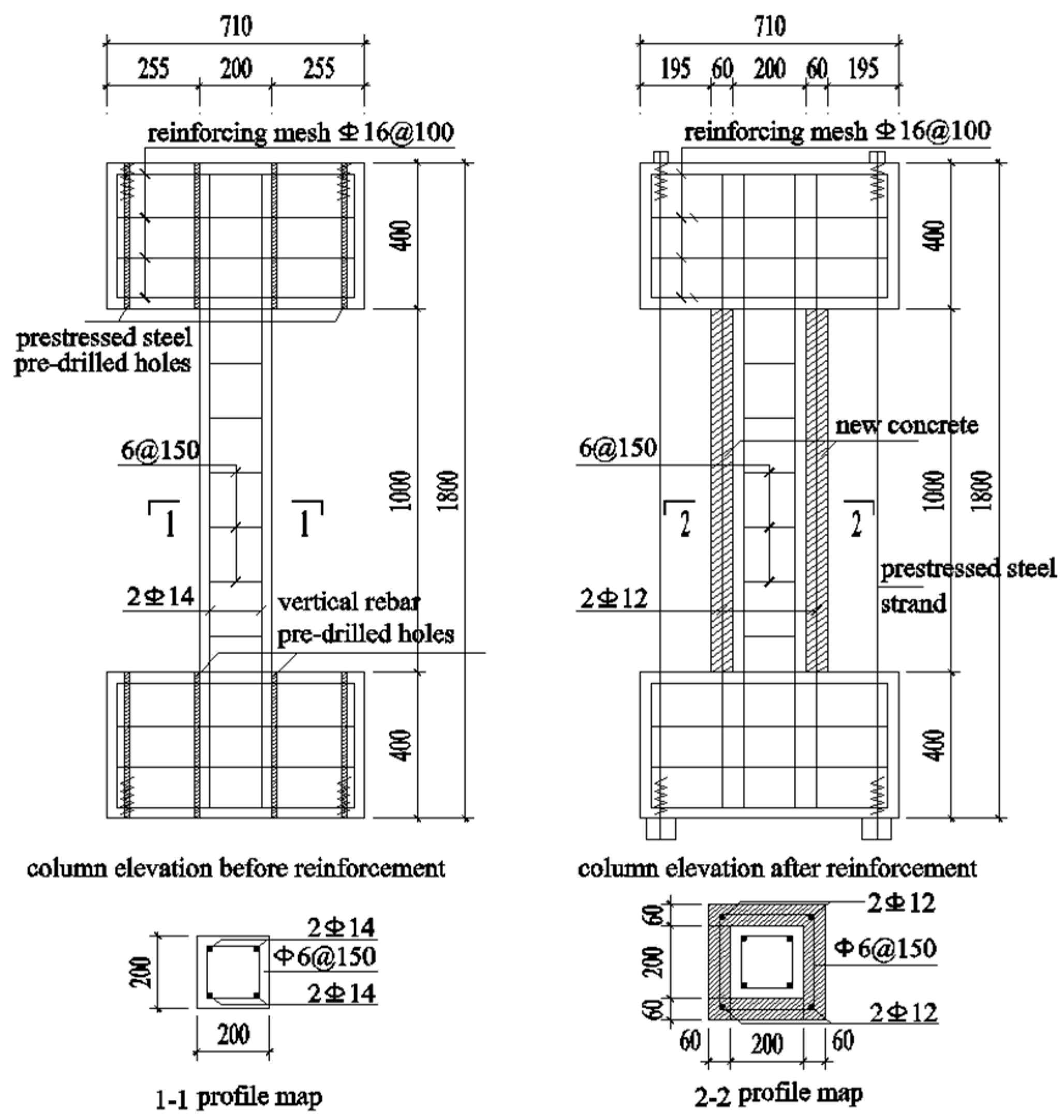


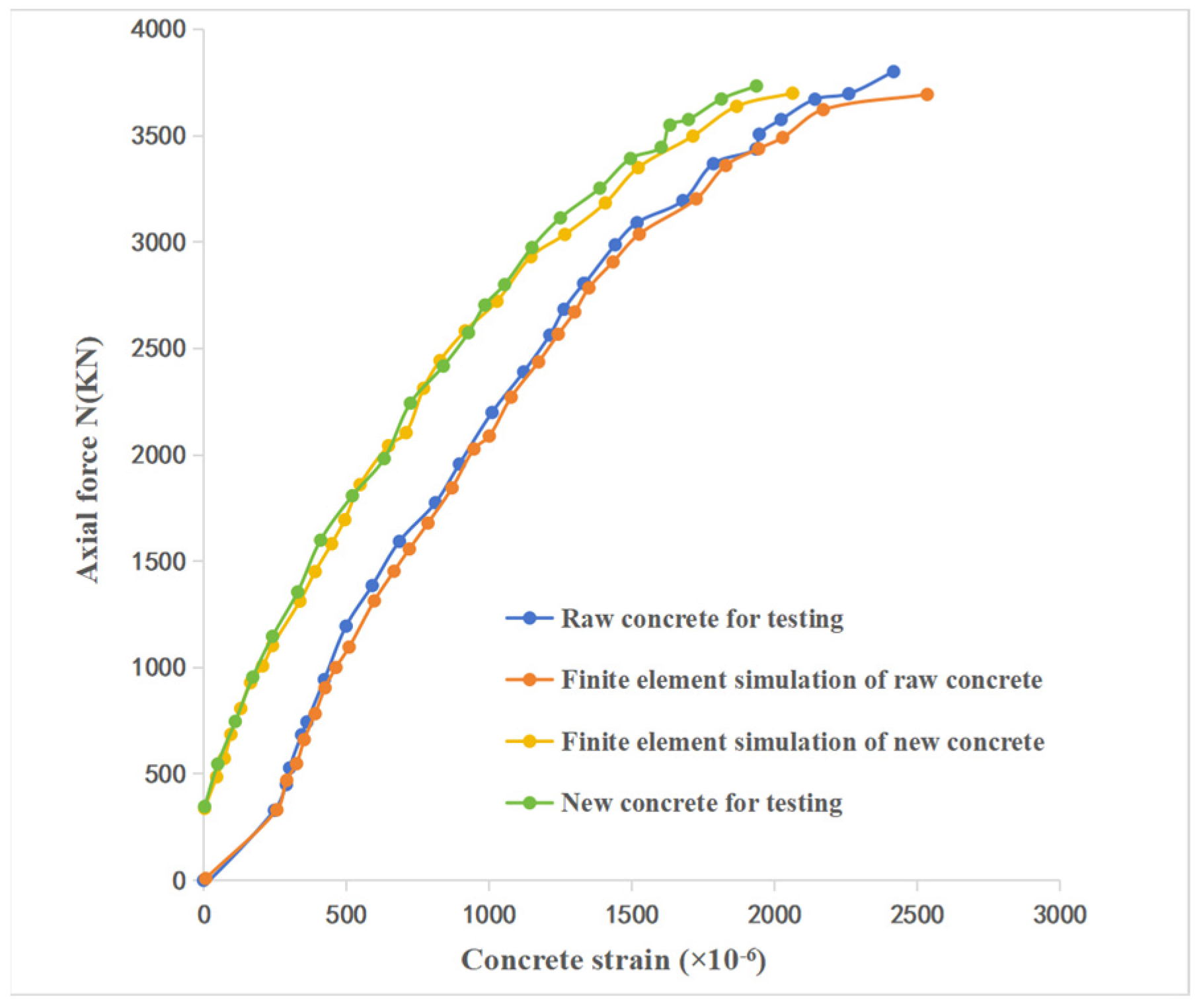
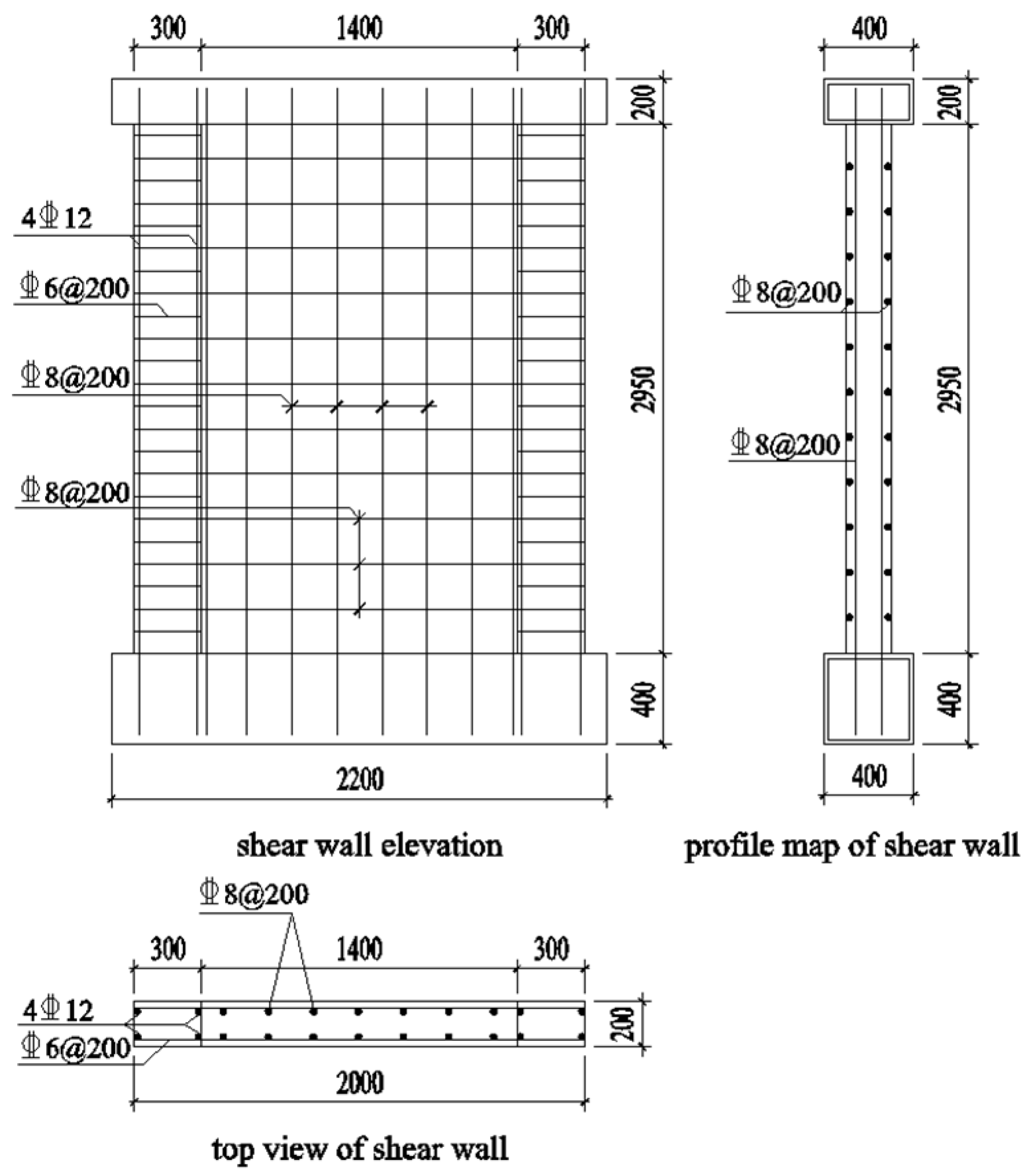
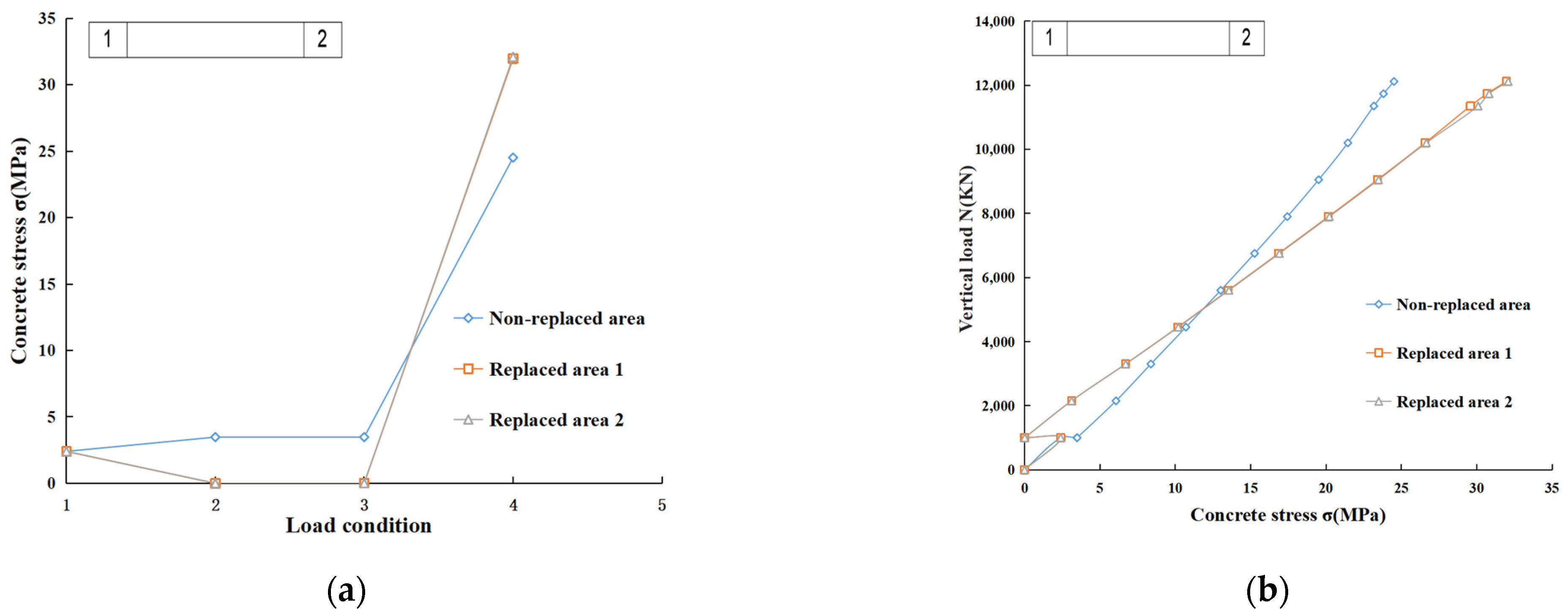
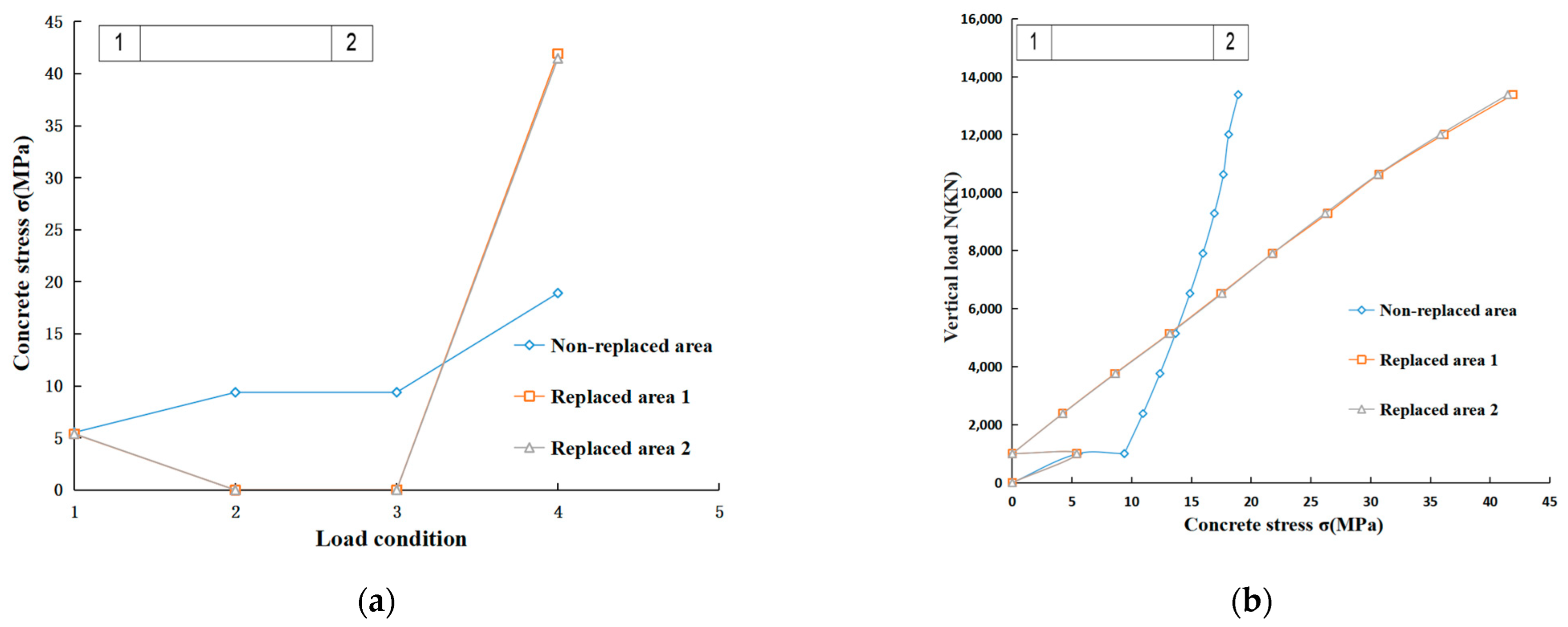

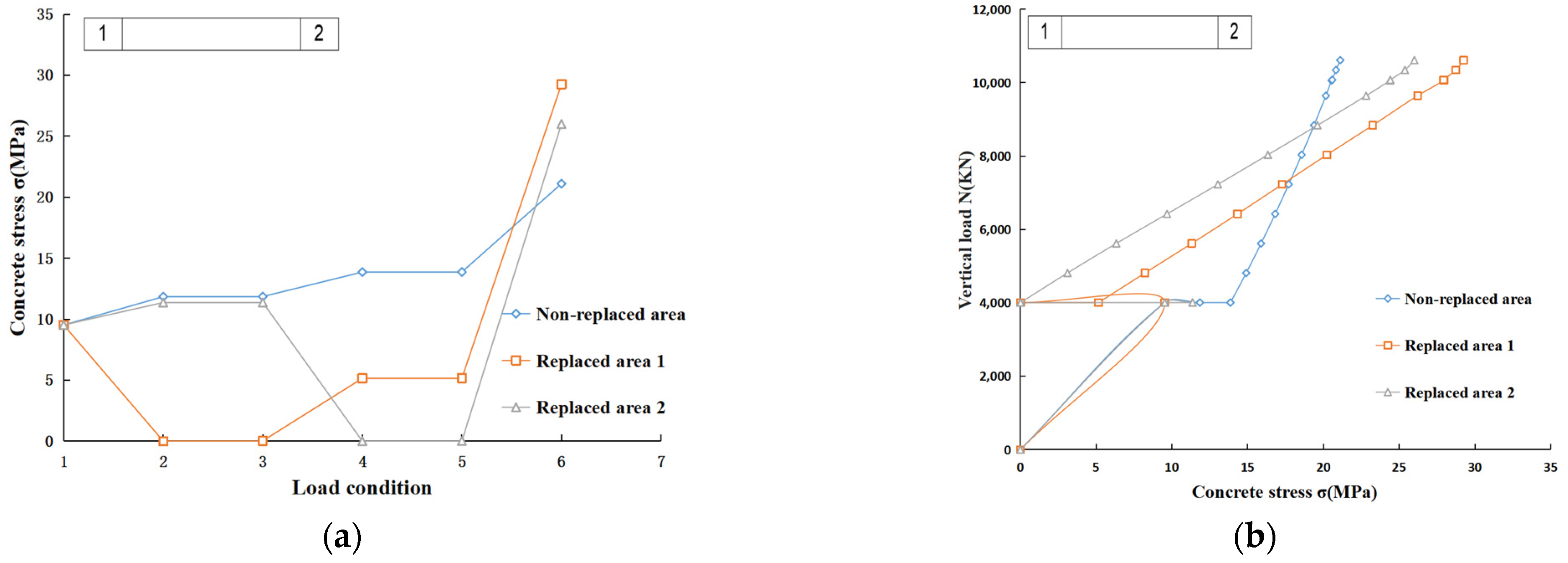
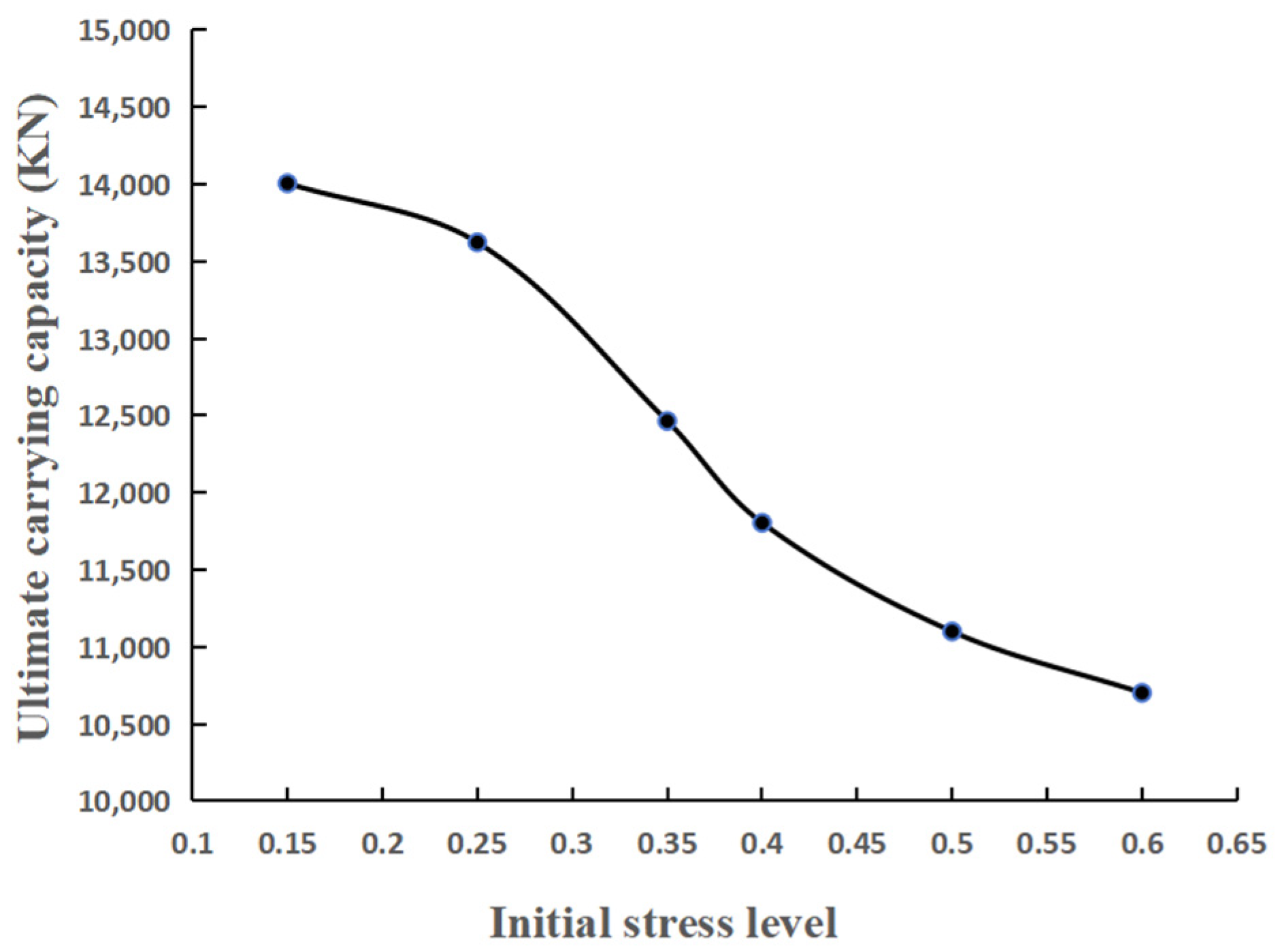
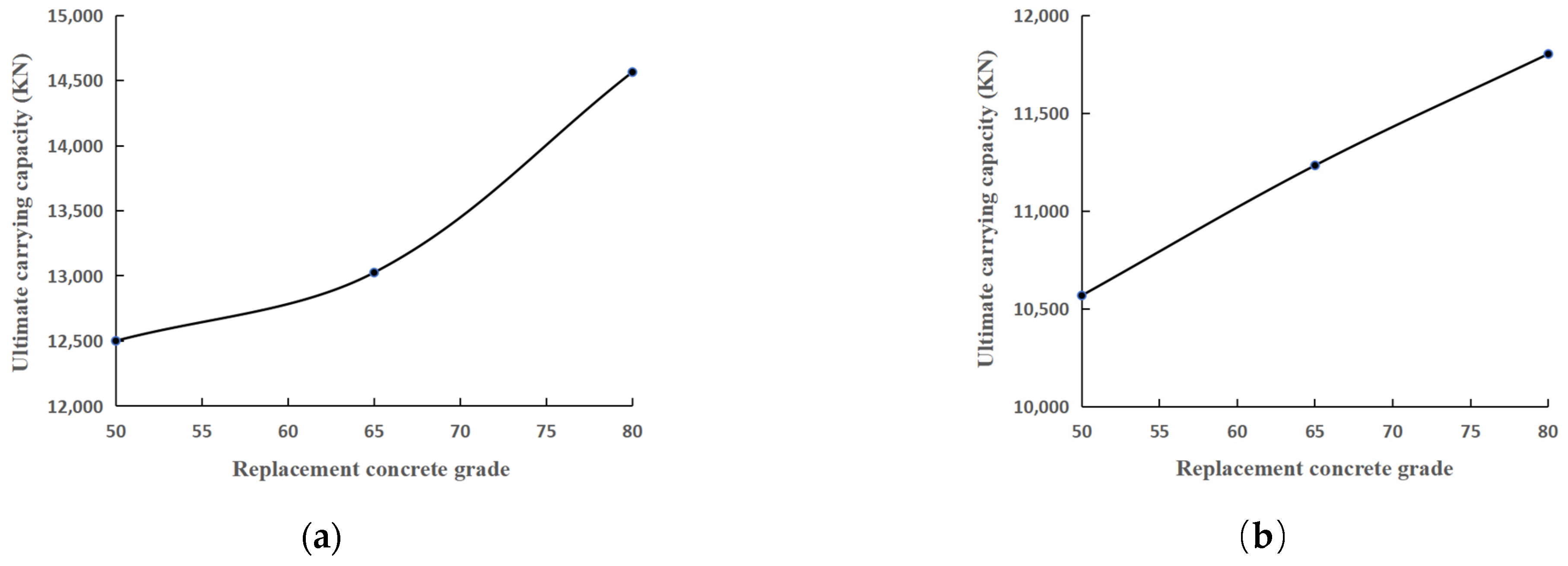
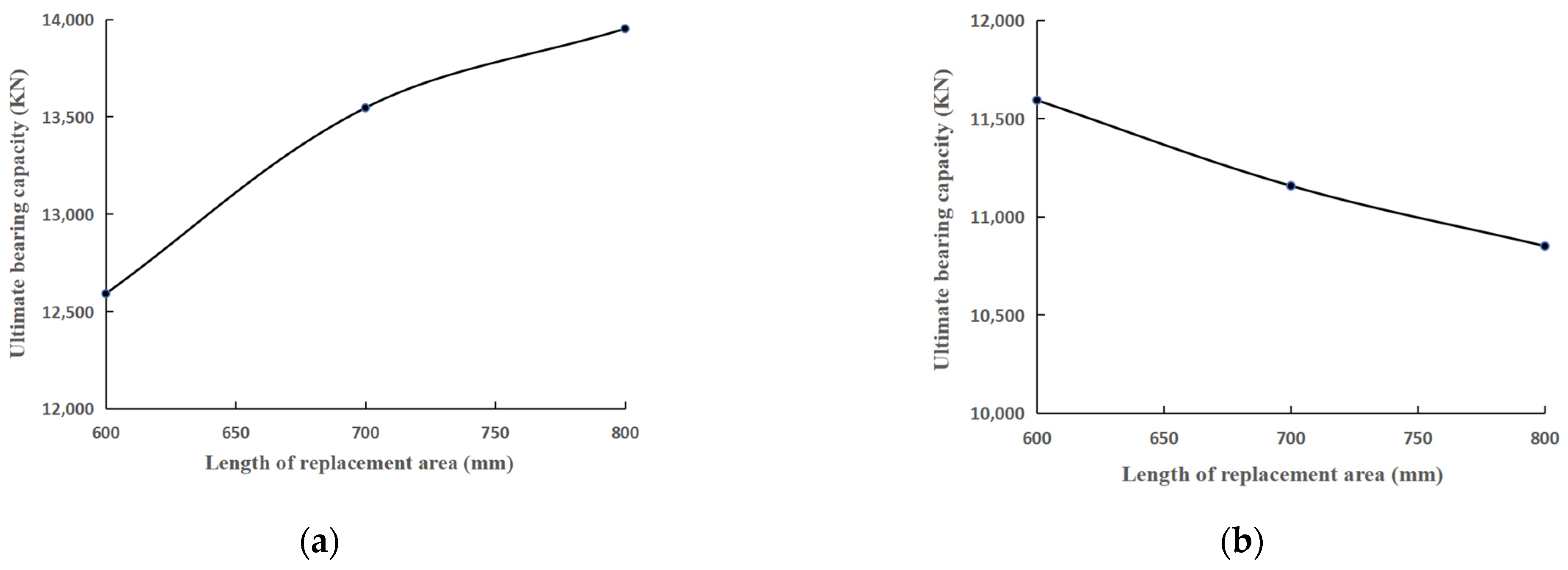
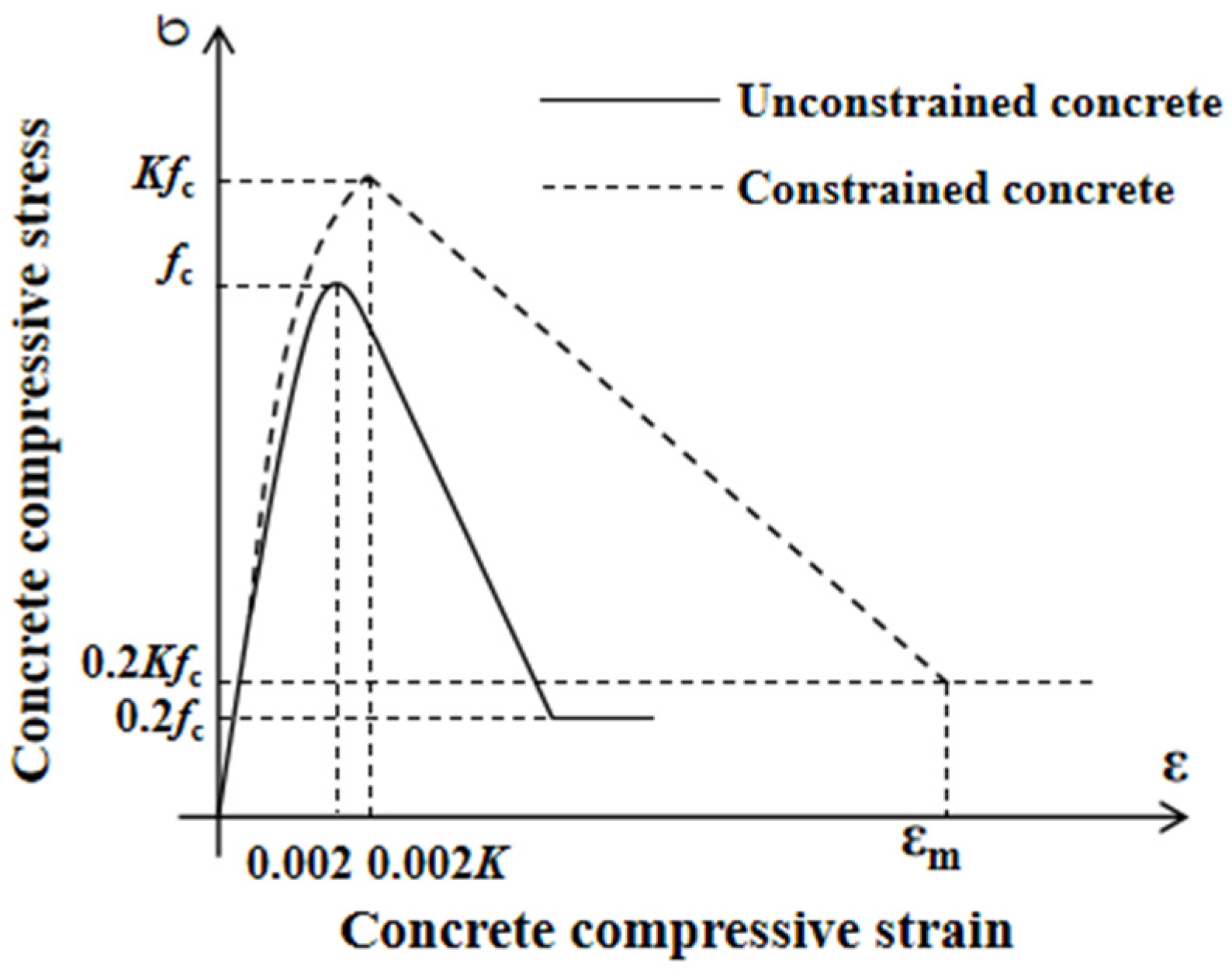
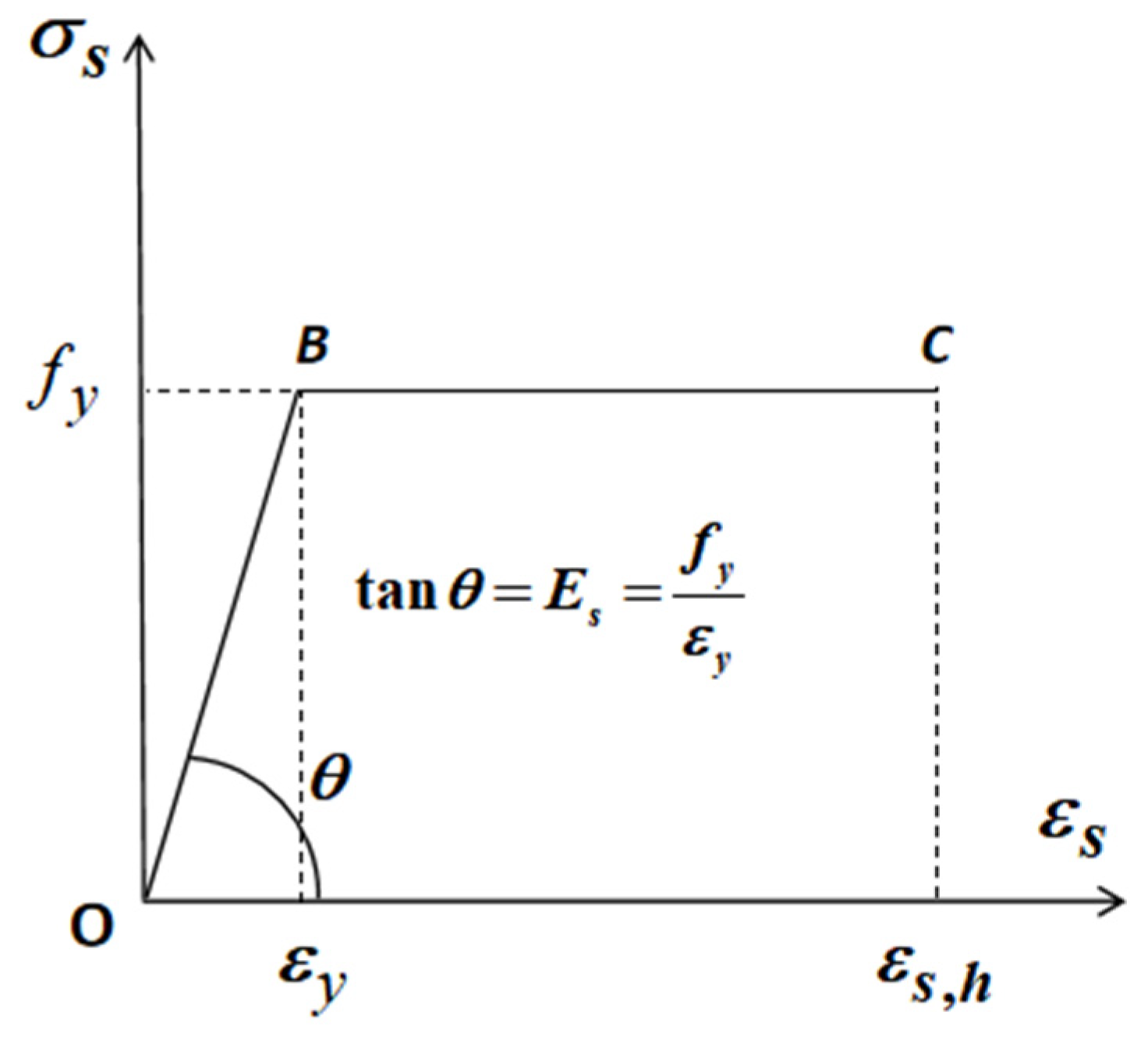

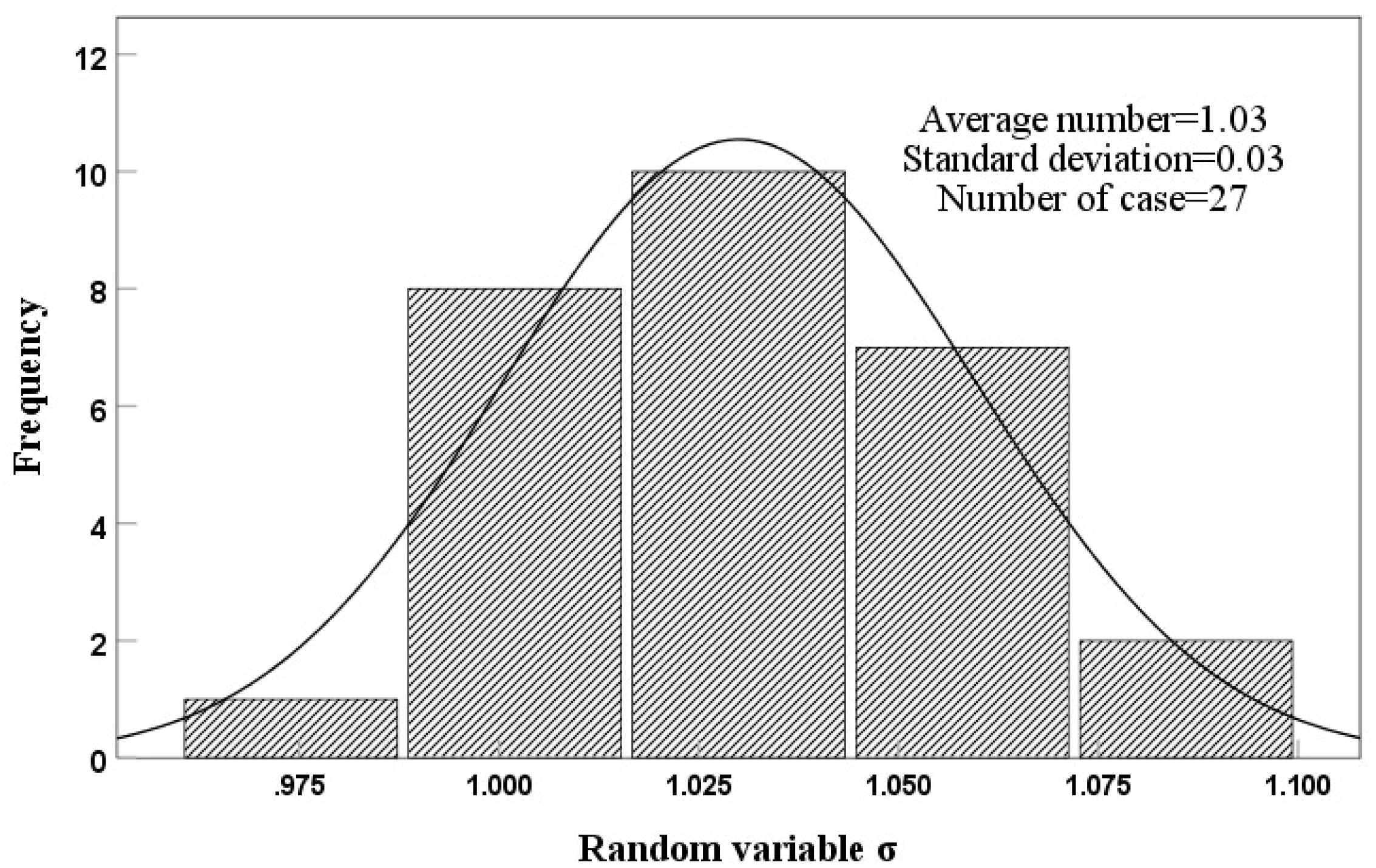
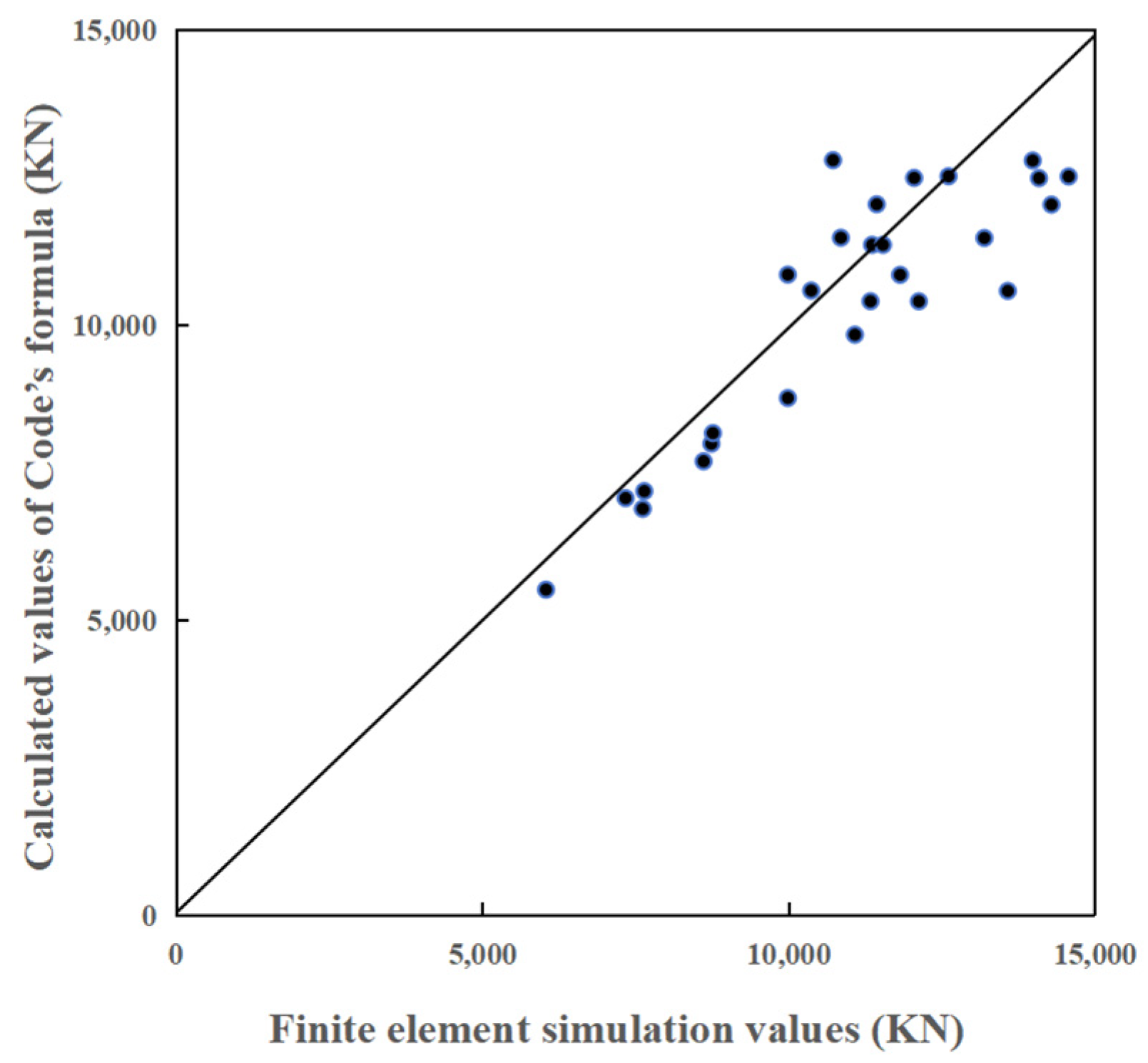
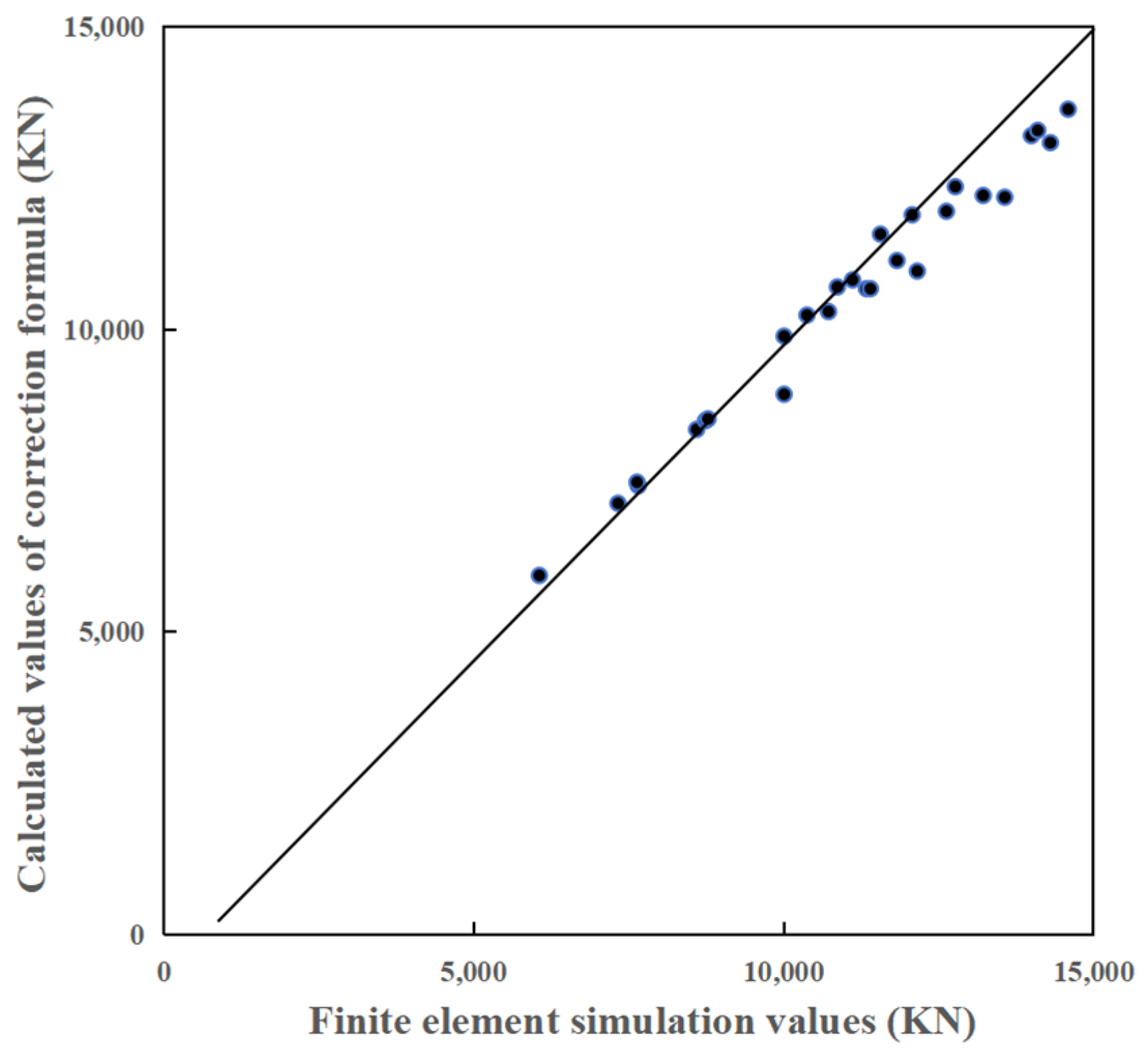
| Influencing Factor | Level | |||||
|---|---|---|---|---|---|---|
| Initial stress level | 0.15 | 0.25 | 0.35 | 0.4 | 0.5 | 0.6 |
| Replacement concrete grade | C50 | C65 | C80 | |||
| Replacement section size (mm × mm) | 300 × 200 | 350 × 200 | 400 × 200 | |||
| Reinforcement ratio of a concealed column | 0.85% | 1.50% | profile steel | |||
| Specimen | Initial Stress Level | Replacement Concrete Grade | Length of Replaced Wall (mm) | Reinforcement Ratio of a Concealed Column | Replacement Batch |
|---|---|---|---|---|---|
| YPZH-1 | 0.15 | C50 | 300 × 2 | 0.85% | one-batch |
| YPZH-2 | 0.15 | C65 | 400 × 2 | 1.50% | one-batch |
| YPZH-3 | 0.15 | C80 | 350 × 2 | profile steel | one-batch |
| YPZH-4 | 0.25 | C50 | 400 × 2 | profile steel | one-batch |
| YPZH-5 | 0.25 | C65 | 350 × 2 | 0.85% | one-batch |
| YPZH-6 | 0.25 | C80 | 300 × 2 | 1.50% | one-batch |
| YPZH-7 | 0.35 | C50 | 350 × 2 | 1.50% | one-batch |
| YPZH-8 | 0.35 | C65 | 300 × 2 | profile steel | one-batch |
| YPZH-9 | 0.35 | C80 | 400 × 2 | 0.85% | one-batch |
| EPZH-10 | 0.4 | C50 | 300 × 2 | 0.85% | two-batch |
| EPZH-11 | 0.4 | C65 | 400 × 2 | 1.50% | two-batch |
| EPZH-12 | 0.4 | C80 | 350 × 2 | profile steel | two-batch |
| EPZH-13 | 0.5 | C50 | 400 × 2 | profile steel | two-batch |
| EPZH-14 | 0.5 | C65 | 350 × 2 | 0.85% | two-batch |
| EPZH-15 | 0.5 | C80 | 300 × 2 | 1.50% | two-batch |
| EPZH-16 | 0.6 | C50 | 350 × 2 | 1.50% | two-batch |
| EPZH-17 | 0.6 | C65 | 300 × 2 | profile steel | two-batch |
| EPZH-18 | 0.6 | C80 | 400 × 2 | 0.85% | two-batch |
| Specimen | Simulation Value of the Ultimate Bearing Capacity in VFEAP (KN) | Stress in the Ultimate State (Mpa) | Concrete Strength Utilization Coefficient | ||||
|---|---|---|---|---|---|---|---|
| Area 1 | Non-Replaced Area | Area 2 | Area 1 | Non-Replaced Area | Area 2 | ||
| YPZH-1 | 12,119 | 32.0 | 24.5 | 32.1 | 0.99 | 1.05 | 0.99 |
| YPZH-2 | 14,302 | 40.0 | 24.6 | 39.4 | 0.96 | 1.05 | 0.95 |
| YPZH-3 | 15,596 | 51.7 | 23.8 | 51.7 | 1.03 | 1.02 | 1.03 |
| YPZH-4 | 13,556 | 32.6 | 26.3 | 32.8 | 1.01 | 1.12 | 1.01 |
| YPZH-5 | 13,214 | 39.3 | 24.2 | 39.8 | 0.95 | 1.03 | 0.96 |
| YPZH-6 | 14,097 | 46.1 | 24.1 | 46.8 | 0.92 | 1.03 | 0.93 |
| YPZH-7 | 11,830 | 28.9 | 20.0 | 29.1 | 0.89 | 0.86 | 0.90 |
| YPZH-8 | 11,561 | 42.8 | 21.4 | 42.7 | 1.03 | 0.91 | 1.03 |
| YPZH-9 | 14,000 | 41.9 | 18.9 | 41.5 | 0.84 | 0.81 | 0.83 |
| EPZH-10 | 11,335 | 28.2 | 23.0 | 27.8 | 0.87 | 0.98 | 0.86 |
| EPZH-11 | 11,456 | 31.0 | 21.1 | 29.7 | 0.75 | 0.90 | 0.71 |
| EPZH-12 | 12,620 | 35.9 | 21.4 | 34.4 | 0.71 | 0.91 | 0.69 |
| EPZH-13 | 10,374 | 24.7 | 21.2 | 22.3 | 0.76 | 0.91 | 0.69 |
| EPZH-14 | 10,860 | 28.2 | 21.6 | 27.3 | 0.68 | 0.92 | 0.66 |
| EPZH-15 | 12,063 | 36.1 | 22.2 | 35.8 | 0.72 | 0.95 | 0.71 |
| EPZH-16 | 9995 | 23.4 | 22.1 | 20.9 | 0.72 | 0.94 | 0.65 |
| EPZH-17 | 11,383 | 27.6 | 22.7 | 26.6 | 0.67 | 0.97 | 0.64 |
| EPZH-18 | 10,725 | 29.3 | 21.1 | 26.0 | 0.58 | 0.90 | 0.52 |
| Factor | Initial Stress Level | Strength of the Replacement Concrete | The Size of Replaced Area | |
|---|---|---|---|---|
| Orthogonal analysis of one-batch replacement | K1 | 42,017 | 37,505 | 37,777 |
| K2 | 40,867 | 39,077 | 40,640 | |
| K3 | 37,391 | 43,693 | 41,858 | |
| k11 | 14,005.7 | 12,501.7 | 12,592.3 | |
| k22 | 13,622.3 | 13,025.7 | 13,546.7 | |
| k33 | 12,463.7 | 14,564.3 | 13,952.7 | |
| Range (R) | 1542 | 2062.6 | 1360.4 | |
| Orthogonal analysis of two-batch replacement | K1 | 35,411 | 31,704 | 34,781 |
| K2 | 33,297 | 33,699 | 33,475 | |
| K3 | 32,103 | 35,408 | 32,555 | |
| k11 | 11,803.7 | 10,568 | 11,593.7 | |
| k22 | 11,099 | 11,233 | 11,158.3 | |
| k33 | 10,701 | 11,802.7 | 10,851.7 | |
| Range (R) | 1102.7 | 1234.7 | 742 |
| Data Source | Specimen | Finite Element Simulation Value N1 (KN) | The Calculated Value N2 of the Formula in this Paper (KN) | Ratio of N1 to N2 | The Calculated Value N3 of the Code’s Formula (KN) | Ratio of N1 to N3 |
|---|---|---|---|---|---|---|
| VFEAP simulation in this study | YPZH-1 | 12,119 | 10,980 | 1.104 | 10,441 | 1.161 |
| YPZH-2 | 14,302 | 13,065 | 1.095 | 10,758 | 1.329 | |
| YPZH-3 | 15,596 | 13,615 | 1.146 | 11,754 | 1.327 | |
| YPZH-4 | 13,556 | 12,170 | 1.114 | 9578 | 1.415 | |
| YPZH-5 | 13,214 | 12,190 | 1.084 | 10,846 | 1.218 | |
| YPZH-6 | 14,097 | 13,263 | 1.063 | 12,529 | 1.125 | |
| YPZH-7 | 11,830 | 11,121 | 1.064 | 10,353 | 1.143 | |
| YPZH-8 | 11,561 | 11,552 | 1.001 | 11,387 | 1.015 | |
| YPZH-9 | 14,000 | 13,184 | 1.062 | 11,213 | 1.249 | |
| EPZH-10 | 11,335 | 10,660 | 1.063 | 10,441 | 1.086 | |
| EPZH-11 | 11,456 | 11,353 | 1.009 | 10,758 | 1.065 | |
| EPZH-12 | 12,620 | 11,978 | 1.054 | 11,754 | 1.074 | |
| EPZH-13 | 10,374 | 10,218 | 1.015 | 9578 | 1.083 | |
| EPZH-14 | 10,860 | 10,699 | 1.015 | 10,876 | 0.999 | |
| EPZH-15 | 12,063 | 11,869 | 1.016 | 12,529 | 0.963 | |
| EPZH-16 | 9995 | 9886 | 1.011 | 10,353 | 0.965 | |
| EPZH-17 | 11,383 | 10,657 | 1.068 | 11,397 | 0.999 | |
| EPZH-18 | 10,725 | 10,289 | 1.042 | 11,213 | 0.956 | |
| Yao Zexin [17] | ZH-1 | 9065 | 5922 | 1.531 | 5550 | 1.633 |
| ZH-2 | 9647 | 8348 | 1.156 | 7734 | 1.247 | |
| ZH-3 | 10,055 | 10,010 | 1.004 | 9903 | 1.015 | |
| ZH-4 | 8664 | 7471 | 1.160 | 6924 | 1.251 | |
| ZH-5 | 8988 | 8483 | 1.060 | 8029 | 1.119 | |
| ZH-6 | 9459 | 8522 | 1.110 | 8212 | 1.152 | |
| ZH-7 | 8481 | 7399 | 1.146 | 7224 | 1.174 | |
| ZH-8 | 8861 | 7125 | 1.244 | 7123 | 1.244 | |
| ZH-9 | 9319 | 8914 | 1.045 | 8812 | 1.058 |
Disclaimer/Publisher’s Note: The statements, opinions and data contained in all publications are solely those of the individual author(s) and contributor(s) and not of MDPI and/or the editor(s). MDPI and/or the editor(s) disclaim responsibility for any injury to people or property resulting from any ideas, methods, instructions or products referred to in the content. |
© 2024 by the authors. Licensee MDPI, Basel, Switzerland. This article is an open access article distributed under the terms and conditions of the Creative Commons Attribution (CC BY) license (https://creativecommons.org/licenses/by/4.0/).
Share and Cite
Liu, Y.; Deng, J.; Jia, Y.; Wu, G.; Ke, N.; Wei, X. A Study on the Bearing Performance of an RC Axial Compression Shear Wall Strengthened by a Replacement Method Using Local Reinforcement with an Unsupported Roof. Buildings 2024, 14, 2926. https://doi.org/10.3390/buildings14092926
Liu Y, Deng J, Jia Y, Wu G, Ke N, Wei X. A Study on the Bearing Performance of an RC Axial Compression Shear Wall Strengthened by a Replacement Method Using Local Reinforcement with an Unsupported Roof. Buildings. 2024; 14(9):2926. https://doi.org/10.3390/buildings14092926
Chicago/Turabian StyleLiu, Yuanwen, Jie Deng, Yigang Jia, Guangyu Wu, Naiwen Ke, and Xianglan Wei. 2024. "A Study on the Bearing Performance of an RC Axial Compression Shear Wall Strengthened by a Replacement Method Using Local Reinforcement with an Unsupported Roof" Buildings 14, no. 9: 2926. https://doi.org/10.3390/buildings14092926
APA StyleLiu, Y., Deng, J., Jia, Y., Wu, G., Ke, N., & Wei, X. (2024). A Study on the Bearing Performance of an RC Axial Compression Shear Wall Strengthened by a Replacement Method Using Local Reinforcement with an Unsupported Roof. Buildings, 14(9), 2926. https://doi.org/10.3390/buildings14092926





